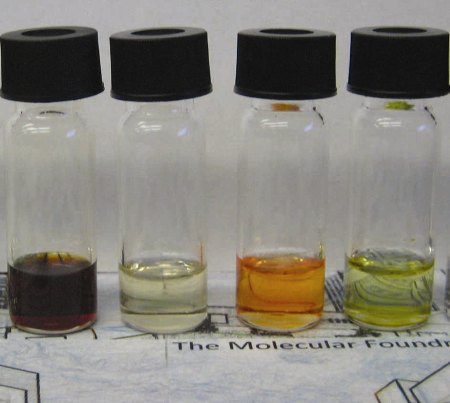A research team at the Lawrence Berkeley National Laboratory (Berkeley Lab) of the U.S. Department of Energy has developed a novel method for removing nanocrytals from tether-like molecules called ligands that prevent integration of nanocrystals with devices, paving the way for designing nanocrystal-based technologies for LEDs, solar fuels, smart windows, photovoltaics and energy storage.
 Vials of ligand-free nanocrystals dispersed in solution for various applications, including energy storage, smart windows and LEDs.
Vials of ligand-free nanocrystals dispersed in solution for various applications, including energy storage, smart windows and LEDs.
Ligands, which are organometallic or hydrocarbon-based molecules, are used to provide stability to nanocrystals during the preparation of its chemical solution wherein the molecules are chemically attached to their surface. However, these molecules encapsulate the nanocrystals with an unwanted insulating shield, whose removal has been a major challenge to the researchers for the past several years.
The research team at Berkeley Lab has used chemical compounds based on Meerwein’s salt or triethyloxonium tetrafluoroborate for the clean removal of the organic ligands in order to form a naked nanocrystal surface for various applications. The salt prevents the re-bonding of the ligands to the nanocrystal surface by reacting chemically with the nanomaterial, resulting in the formation of a thin film over a support or ligand-free, bare nanocrystals in solution. For the study, the team used a semiconductor nanomaterial, lead selenide nanocrystal and ligands encircling its exterior.
Using nanoscale infrared spectroscopy, the research team has confirmed the clean removal of ligands through a comparison study between thin films of naked lead selenide nanocrystals and ligand-coated selenide nanocrystals. In the study, the team discovered that bare nanocrystals have a superior electronic conductivity caused by their bare surface than that of the ligand-coated selenide nanocrystals.
Brett Helms, one of the researchers, stated that the novel technique is capable of producing zero-ligand nanocrystal inks using any type of nanocrystals, including semiconductors, metallic and metal oxides, for spray or spin coating or even for patterning utilizing an inkjet printer.